THE venue for the International Horticultural Exhibition 2019 Beijing is located in the southwestern part of Yanqing District, next to the Guanting Reservoir and along the banks of the Guishui River. It is about 10 kilometers away from the Badaling Great Wall. Strolling in the Expo Park surrounded by lush mountains and lucid waters, visitors can feel a really “beautiful China.”
Innovative Design
The park includes: one core scenic area (International Pavilion, China Pavilion, Plant Pavilion, Horticultural Experience Pavilion, and Guirui Theater), two axes (Chinese Landscape Horticulture and International Horticulture), three belts (the Guishui River Ecological Leisure Belt, Horticultural Experience Belt, and Horticultural Industry Development Belt), and multiple display areas (International Horticulture, Chinese Horticulture, Education and the Future, Horticulture for Life and Natural Environment).
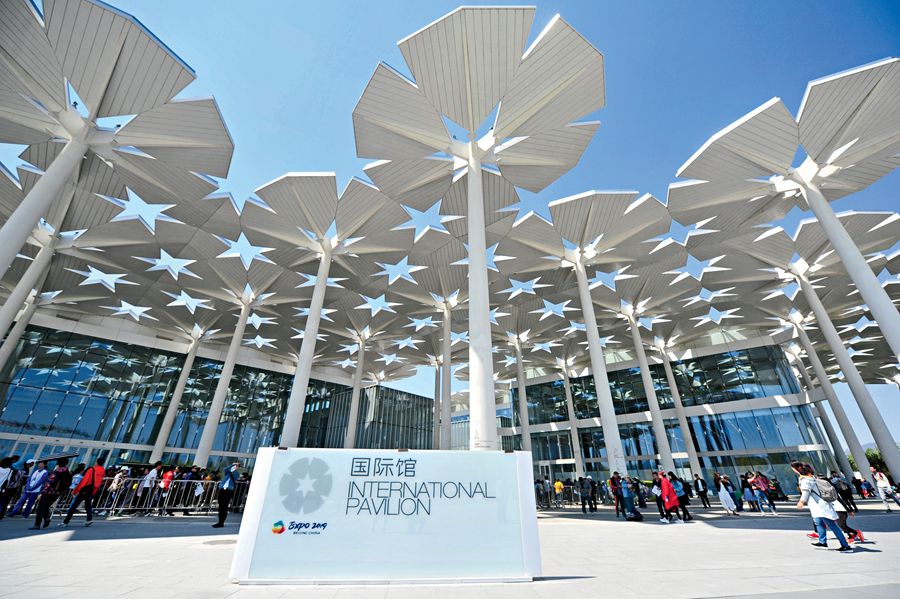
The International Pavilion of the Expo highlights the concept of integration. It is designed to allow display of the horticultural characteristics and cultures of different countries.
A semi-circular building stretches between the mountains and the blue waters. The ends of the roof are slightly tilted, like a baby bird spreading its wings. This is the China Pavilion which was designed following a concept of eternity and Chinese traditional aesthetics. It brings together the ecological construction accomplishments of 31 provinces, autonomous regions and municipalities in China, as well as cutting-edge horticultural achievements from research institutions, whilst displaying aspects of China’s intangible cultural heritage like Chinese flower arrangements.
The 94 parasol flowers, like an ocean of blossoms, bring freshness to the atmosphere. Whether you get a bird’s eye view or stroll beneath them, you will be impressed with this awe-inspiring creation. With a theme of “All Flowers Bloom Together,” the International Pavilion displays the distinctive gardening culture of nations and regions from across the world.
The Plant Pavilion follows a concept of “rising horizon.” The design is inspired by massive roots spreading downwards to exhibit the power of life. It takes visitors on a journey of the wonderful world of plants.
The Horticultural Experience Pavilion is designed based on a philosophy of “loving horticulture, loving life.” Visitors can experience the application of horticulture in clothing, food, housing, entertainment, and health care. It is a place full of joy, a place that takes people back to idyllic life, and a place representing green life.
The magnificent Guirui Theater is like a colorful butterfly on the shores of Guirui Lake, looking afar to the Yongning Pavilion on the opposite side. There are altogether 1,000 seats in the main theater and 200 seats in the small one, where various cultural performances are held.
Hi-Tech Gardens
The exquisitely designed green expo is also appealing to visitors because it features a dazzling array of advanced technologies.
The experience is not only about sightseeing inside the park. In fact, the principles of green lifestyle and ecological conservation have been made tangible in every corner. Some 50,000 trees form the framework of the park, while another 100,000 trees and shrubs help better purify the air, turning the park into a natural oxygen bar and habitat for migratory birds. The 20-kilometer-long waterway enables water cycling inside the park to the largest extent by preserving, filtering, and purifying the rainfall. The 1,024 pieces of photo-voltaic glasses and green trickle irrigation technology make the China Pavilion “a breathing building.”
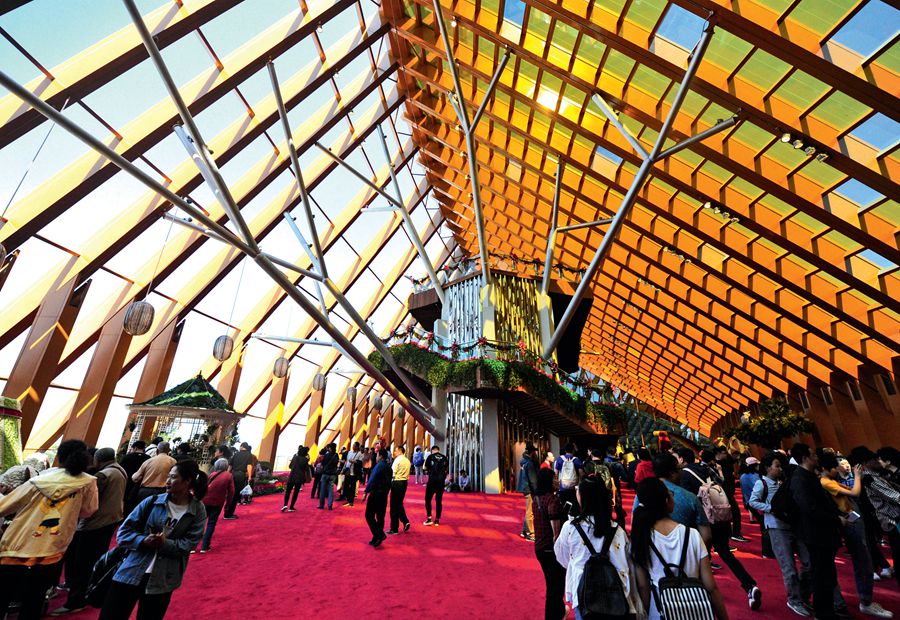
The Chinese Pavilion brings together cutting-edge horticultural achievements from each province and many Chinese research institutes.
The International Pavilion looks like several umbrella-shaped floral clusters, but it is actually a green, eco-friendly building. Sustainable technologies are well applied, such as a solar shading system, natural ventilation, solar photo-voltaic power generation, evaporation cooling, tricke irrigation, and rainwater recycling and utilization. Given the scorching summer in Beijing, these huge, towering floral clusters will serve as a spacious resting area for visitors where they can stand in queue free from worries of being exposed to the scorching summer sun.
The facades of the International Pavilion use the glass curtain wall, and a dormer window is designed on top of the building to guarantee the natural light. The upright columns can collect rainwater and then filter it into the reservoir. If the reservoir gets filled up, excess rainwater will flow into the waterway, and be used for irrigation and cleaning. New types of photo-voltaic power generation materials have been adopted on top of the umbrella-shaped floral clusters to improve power generation efficiency, whilst offering energy supply for interior illumination and functions necessary for system operation.
Black Technologies, such as artificial intelligence, Internet of Things, 5G and big data, are ubiquitous in the park. They are used to build a smart expo where visitors can experience the charms of high technology and a convenient lifestyle.
Unmanned vehicles travel back and forth, working for security and aerial photography. Lamp posts, in addition to giving light, also transmit signals, monitor the park, and are used as display screens. Other black technologies include smart dustbins, intelligent manhole covers, telemedicine devices, unmanned logistics and drones among others.
Plants Linking the World
Plants nurture human civilization, while humans protect the growth of plants.
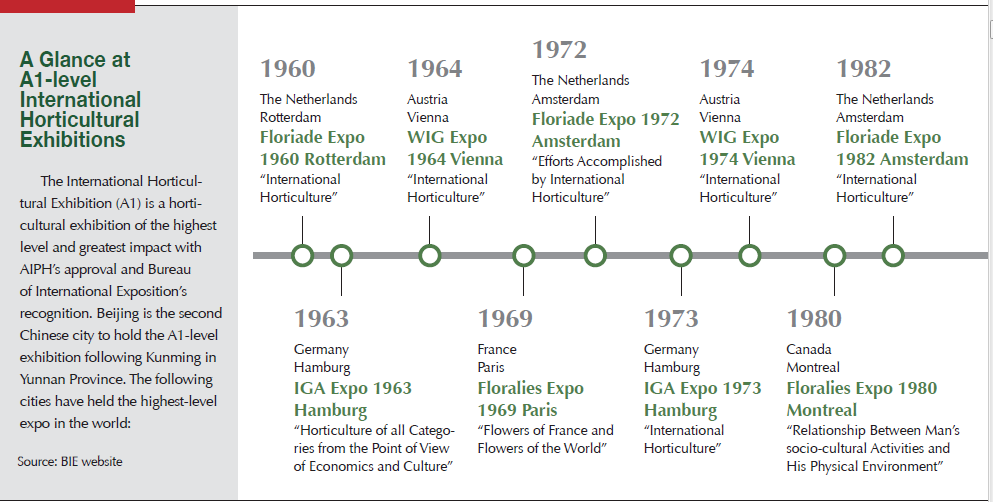
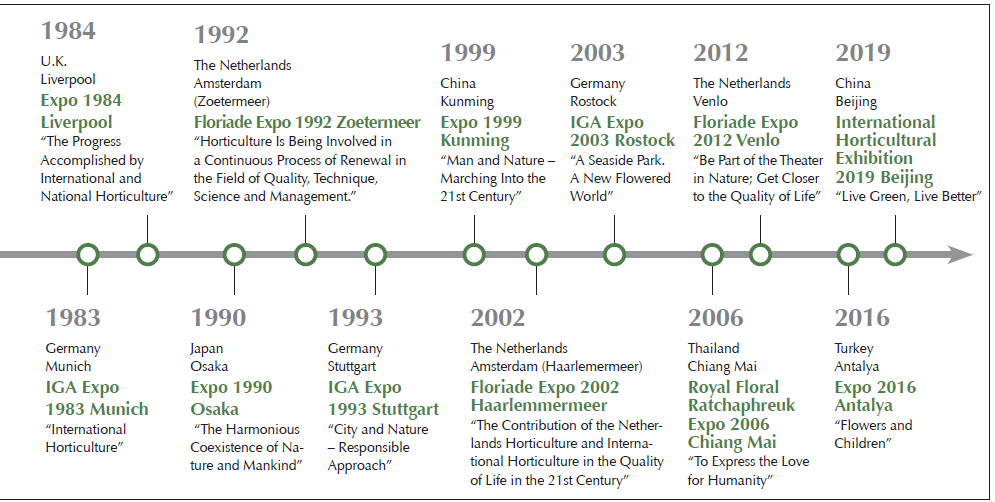
The Plant Pavilion displays the diversity of the plant, the power of life, and how plants adapt to the living environment through over 600 precious species such as mangroves, rainforest, ferns, palms, succulent plants, insectivorous plants, and moss.
Artificial mangroves show visitors how they adapt to the ebb and flow and conserve the coastal ecology. The rainforest showcases the competitive and collaborative relations between various plants, as well as between plants and animals. Palms and ferns reveal the wisdom of their propagation. Succulent plants adapt to the arid environment through abnormal evolution. Insectivorous plants capture insects to obtain nutrition. And even the dwarf moss can find a suitable living space in the vast plant world.
Plants build a bridge for the dialogue among different civilizations. During this Beijing Expo 2019, plants that fall within China’s independent intellectual property rights showcase the scientific outcome China has achieved in plants cultivation, while introducing the Chinese plants that have changed the world.
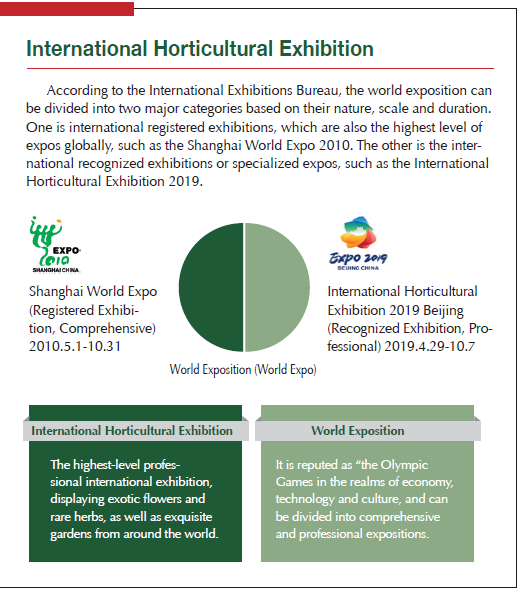
In the 16th century, the Portuguese reached coastal China via sea and brought back citrus fruit to their nation. According to some Western botanists, the citrus is the first type of alien plant that was introduced from China into Europe. Since then, more and more Chinese native plants have traveled all the way across the oceans to Europe and the U.S.
The tiny tea leaf that grows in China had the power to change the world. It has been transported along the ancient Silk Road or shipped far away across the sea, and served in cafes or on dining tables in London, promoting the blending of the Oriental and Occidental civilizations. Some 2,000 years ago, paddy rice spread eastwards to Japan. About 1,000 years ago, paddy rice planting technology was transferred to the Philippines. At present, the colorful and splendid cultures about paddy rice cover one third of the global land area.
China is the origin of mulberry, and the first country which planted mulberry trees and reared silkworms. In the 2nd century, merchants trading silk and other commodities traveled across mountains and rivers, trudged through the barren and desolate desert, and their route finally became the Silk Road that has changed and shaped human history.
At the Expo 2019, there is a special Herb Garden where visitors can experience almost all kinds of Chinese herbal medicine. Basil, caraway, cumin – these medicinal plants which once traveled along the Silk Road tell the history of exchanges between Chinese herbal medicine and the world’s herbs.
Of course, plants that changed the history do not only just exist in China. The diversity of biological civilization has been fully presented at this expo. For example, the terraced fields in the ancient civilization of Incas are regarded as one of the first sites of agricultural experimental bases in the world, where nearly 5,000 species of potatoes and sweet potatoes, as well as roots and tuber crops growing beneath the soil of the Andes Mountains have preserved the heritage of Inca civilization. The first wild coffee plant grown in Caffa region of Ethiopia has ushered in an arduous and legendary course of communication with the whole world, spreading its seeds from Arabian nations to Asian, European, and American countries and regions. The diversity of human civilizations has been perfectly presented via this process.
The Beijing Expo 2019 will organize a rich variety of activities including more than 2,500 cultural activities. Ten “ecologically festooned vehicles” decorated with plants and flowers showcase 180 parades, telling the stories of plants and presenting the green development vision of modern civilization.




